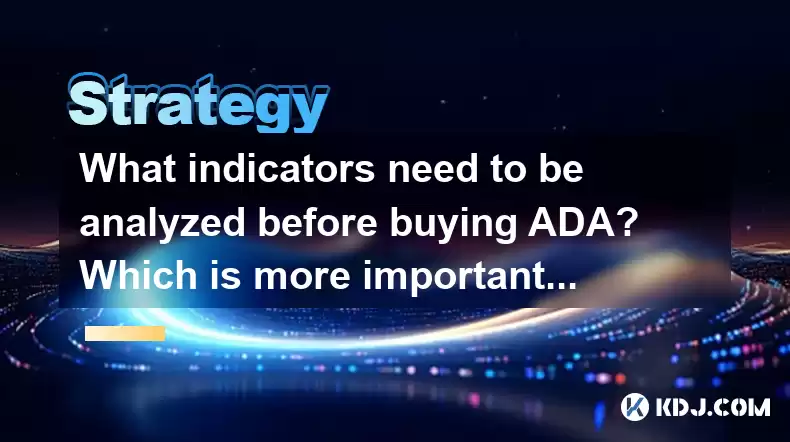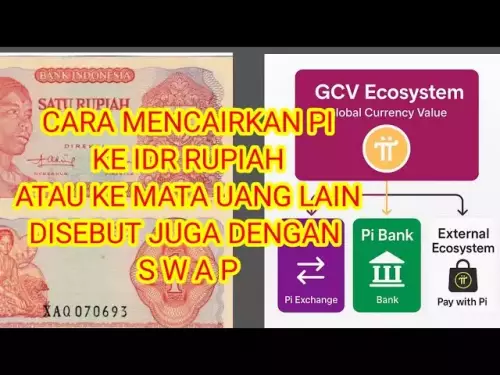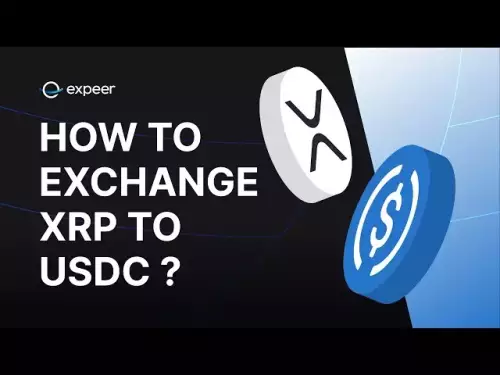-
 bitcoin
bitcoin $112715.707551 USD
-1.71% -
 ethereum
ethereum $4101.475385 USD
-3.01% -
 tether
tether $1.000644 USD
-0.02% -
 bnb
bnb $1207.619465 USD
-6.77% -
 xrp
xrp $2.501451 USD
-3.98% -
 solana
solana $202.947124 USD
-3.32% -
 usd-coin
usd-coin $1.000295 USD
0.04% -
 dogecoin
dogecoin $0.203884 USD
-4.47% -
 tron
tron $0.317154 USD
-1.72% -
 cardano
cardano $0.695009 USD
-4.43% -
 hyperliquid
hyperliquid $38.853961 USD
-8.23% -
 chainlink
chainlink $18.988674 USD
-4.64% -
 ethena-usde
ethena-usde $1.000233 USD
-0.03% -
 stellar
stellar $0.337050 USD
-3.63% -
 bitcoin-cash
bitcoin-cash $536.861728 USD
-1.28%
What indicators need to be analyzed before buying ADA? Which is more important, technical or fundamental?
Before investing in Cardano (ADA), analyze technical indicators like moving averages and RSI, and fundamental factors such as development activity and partnerships for a comprehensive view.
Apr 30, 2025 at 12:49 pm

When considering an investment in Cardano (ADA), it's crucial to analyze a variety of indicators to make an informed decision. These indicators can be broadly categorized into technical and fundamental analysis. Both types of analysis play a significant role in understanding the potential of ADA as an investment. In this article, we will delve into the specific indicators you should consider and discuss the relative importance of technical versus fundamental analysis.
Understanding Technical Analysis for ADA
Technical analysis involves studying past market data, primarily price and volume, to predict future price movements. For ADA, several key technical indicators should be analyzed before making a purchase decision.
Moving Averages: These help identify the trend direction of ADA's price. The most commonly used moving averages are the 50-day and 200-day moving averages. If the 50-day moving average crosses above the 200-day moving average, it's known as a 'golden cross' and is considered a bullish signal. Conversely, a 'death cross' occurs when the 50-day moving average falls below the 200-day moving average, indicating a bearish trend.
Relative Strength Index (RSI): The RSI measures the speed and change of price movements. It oscillates between 0 and 100 and is typically used to identify overbought or oversold conditions. An RSI above 70 suggests that ADA might be overbought, while an RSI below 30 indicates that it might be oversold.
Bollinger Bands: These are used to measure the volatility of ADA's price. The bands consist of a middle band (a moving average) and two outer bands that are standard deviations away from the middle band. When the bands widen, it indicates increased volatility, and when they contract, it suggests decreased volatility. A price touching the upper band might indicate a potential sell signal, while touching the lower band might suggest a buy signal.
Volume: Analyzing the trading volume of ADA can provide insights into the strength of a price move. High volume during a price increase suggests strong buying interest, while high volume during a price decrease indicates strong selling pressure.
Understanding Fundamental Analysis for ADA
Fundamental analysis involves evaluating the intrinsic value of ADA based on various qualitative and quantitative factors related to the Cardano project itself. Here are some key fundamental indicators to consider:
Development Activity: Cardano's development activity can be tracked through GitHub. A high level of development activity, including regular updates and new features, suggests that the project is actively being improved and maintained.
Team and Partnerships: The expertise and reputation of the Cardano team, as well as their partnerships with other organizations, can significantly impact the project's potential. Strong partnerships with reputable companies or institutions can enhance ADA's credibility and utility.
Adoption and Use Cases: The level of adoption and the number of use cases for ADA are crucial indicators of its long-term viability. Projects that are being used in real-world applications and have a growing user base are generally considered more promising.
Market Sentiment: The overall sentiment in the cryptocurrency community towards Cardano can influence ADA's price. Positive sentiment can drive up demand, while negative sentiment can lead to a decrease in price.
Comparing Technical and Fundamental Analysis
Both technical and fundamental analysis provide valuable insights, but they serve different purposes and are used in different ways.
Technical Analysis: This is more focused on short-term price movements and is often used by traders looking to capitalize on market trends. Technical indicators can help identify entry and exit points for buying and selling ADA. However, technical analysis alone does not provide a complete picture of the underlying value of ADA.
Fundamental Analysis: This is more suited for long-term investors who are interested in the intrinsic value and long-term potential of ADA. Fundamental indicators can help investors understand the project's strengths, weaknesses, opportunities, and threats. However, fundamental analysis may not be as effective in predicting short-term price movements.
Which is More Important: Technical or Fundamental Analysis?
The importance of technical versus fundamental analysis depends on your investment goals and time horizon.
For Short-Term Trading: If you are looking to buy and sell ADA within a short period, technical analysis is likely more important. It can help you identify short-term trends and make timely decisions based on price movements and market volatility.
For Long-Term Investing: If you are planning to hold ADA for an extended period, fundamental analysis is likely more critical. Understanding the project's development, team, partnerships, and adoption can help you assess its long-term potential and make informed investment decisions.
Combining Both: Many investors find that combining technical and fundamental analysis provides the most comprehensive view. By using technical analysis to time their entry and exit points and fundamental analysis to evaluate the long-term potential of ADA, investors can make more informed and balanced decisions.
Practical Steps to Analyze ADA Before Buying
To effectively analyze ADA before making a purchase, follow these practical steps:
Gather Data: Start by collecting relevant data on ADA's price history, trading volume, and technical indicators. You can use platforms like TradingView or CoinGecko to access this information.
Analyze Technical Indicators: Use the technical indicators discussed earlier (moving averages, RSI, Bollinger Bands, and volume) to assess ADA's current market conditions and potential price movements.
Research Fundamental Factors: Investigate Cardano's development activity, team, partnerships, and adoption. Resources like Cardano's official website, GitHub, and cryptocurrency news sites can provide valuable insights.
Evaluate Market Sentiment: Monitor social media, forums, and news outlets to gauge the overall sentiment towards Cardano and ADA. Tools like Sentiment can help quantify the sentiment analysis.
Make a Decision: Based on your analysis, decide whether ADA aligns with your investment goals and risk tolerance. If the technical and fundamental indicators suggest a favorable outlook, you may choose to proceed with the purchase.
Frequently Asked Questions
Q1: Can I use only technical analysis to invest in ADA?A1: While technical analysis can be effective for short-term trading, relying solely on it may not provide a complete understanding of ADA's long-term potential. Combining technical analysis with fundamental analysis can offer a more comprehensive view and help you make more informed investment decisions.
Q2: How often should I review my analysis of ADA?A2: The frequency of reviewing your analysis depends on your investment strategy. For short-term traders, daily or even hourly reviews may be necessary to stay on top of market movements. For long-term investors, monthly or quarterly reviews might be sufficient to assess any changes in Cardano's fundamentals and market conditions.
Q3: Are there any tools that can help me analyze ADA more effectively?A3: Yes, several tools can aid in analyzing ADA. For technical analysis, platforms like TradingView and CoinGecko offer comprehensive charting and indicator tools. For fundamental analysis, resources like Cardano's official website, GitHub, and cryptocurrency news sites provide valuable information. Additionally, sentiment analysis tools like Sentiment can help gauge market sentiment.
Q4: How can I stay updated on Cardano's development and partnerships?A4: To stay updated on Cardano's development and partnerships, regularly visit Cardano's official website and blog, follow their social media channels, and subscribe to their newsletter. Additionally, following reputable cryptocurrency news sites and joining Cardano-focused communities on platforms like Reddit or Telegram can provide timely updates and insights.
Disclaimer:info@kdj.com
The information provided is not trading advice. kdj.com does not assume any responsibility for any investments made based on the information provided in this article. Cryptocurrencies are highly volatile and it is highly recommended that you invest with caution after thorough research!
If you believe that the content used on this website infringes your copyright, please contact us immediately (info@kdj.com) and we will delete it promptly.
- Zero Knowledge Proof, Whitelist, Blockchain 2025: The Dawn of Private, Scalable Infrastructure
- 2025-10-16 01:20:01
- Altcoins, Whales, and Tariff Threats: Navigating the Crypto Seas
- 2025-10-16 01:20:01
- ChatGPT's Crystal Ball: HBAR Price Prediction and the Rise of Snorter in 2025
- 2025-10-16 01:20:01
- ZEROBASE Listing and Airdrop: A New Era for ZK Tech?
- 2025-10-16 00:25:13
- Digital Euro, Gold Standard, and Active Reserves: A New York Minute on the Future of Money
- 2025-10-16 00:25:13
- TCG OTS Pack Spoilers: What's Hot and What's Not?
- 2025-10-16 00:33:47
Related knowledge

Practical parameter settings for a Bitcoin multi-timeframe moving average system
Sep 18,2025 at 10:54pm
Optimizing Timeframe Combinations for Bitcoin Trading1. Selecting appropriate timeframes is crucial when building a multi-timeframe moving average sys...

How can I filter out false breakouts in Dogecoin high-frequency trading?
Sep 22,2025 at 01:00am
Understanding False Breakouts in Dogecoin Trading1. A false breakout occurs when Dogecoin's price appears to move beyond a defined support or resistan...

Techniques for identifying tops and bottoms in the Bitcoin on-chain NVT model
Sep 20,2025 at 07:54pm
Understanding the NVT Model in Bitcoin Analysis1. The Network Value to Transactions (NVT) ratio is often described as the 'P/E ratio' of the cryptocur...

What does the surge in open interest in Bitcoincoin futures mean?
Sep 20,2025 at 11:18pm
Understanding the Surge in Dogecoin Futures Open Interest1. A surge in open interest within Dogecoin futures indicates a growing number of active cont...

How can I use the Ethereum USDT premium to gauge market sentiment?
Sep 18,2025 at 11:55pm
Understanding the Ethereum USDT Premium1. The Ethereum USDT premium refers to the price difference between USDT (Tether) traded on Ethereum-based plat...

What should I do if Ethereum staking yields decline?
Sep 20,2025 at 06:18am
Understanding the Causes Behind Declining Ethereum Staking Yields1. The Ethereum network transitioned to a proof-of-stake consensus mechanism with the...

Practical parameter settings for a Bitcoin multi-timeframe moving average system
Sep 18,2025 at 10:54pm
Optimizing Timeframe Combinations for Bitcoin Trading1. Selecting appropriate timeframes is crucial when building a multi-timeframe moving average sys...

How can I filter out false breakouts in Dogecoin high-frequency trading?
Sep 22,2025 at 01:00am
Understanding False Breakouts in Dogecoin Trading1. A false breakout occurs when Dogecoin's price appears to move beyond a defined support or resistan...

Techniques for identifying tops and bottoms in the Bitcoin on-chain NVT model
Sep 20,2025 at 07:54pm
Understanding the NVT Model in Bitcoin Analysis1. The Network Value to Transactions (NVT) ratio is often described as the 'P/E ratio' of the cryptocur...

What does the surge in open interest in Bitcoincoin futures mean?
Sep 20,2025 at 11:18pm
Understanding the Surge in Dogecoin Futures Open Interest1. A surge in open interest within Dogecoin futures indicates a growing number of active cont...

How can I use the Ethereum USDT premium to gauge market sentiment?
Sep 18,2025 at 11:55pm
Understanding the Ethereum USDT Premium1. The Ethereum USDT premium refers to the price difference between USDT (Tether) traded on Ethereum-based plat...

What should I do if Ethereum staking yields decline?
Sep 20,2025 at 06:18am
Understanding the Causes Behind Declining Ethereum Staking Yields1. The Ethereum network transitioned to a proof-of-stake consensus mechanism with the...
See all articles










































































